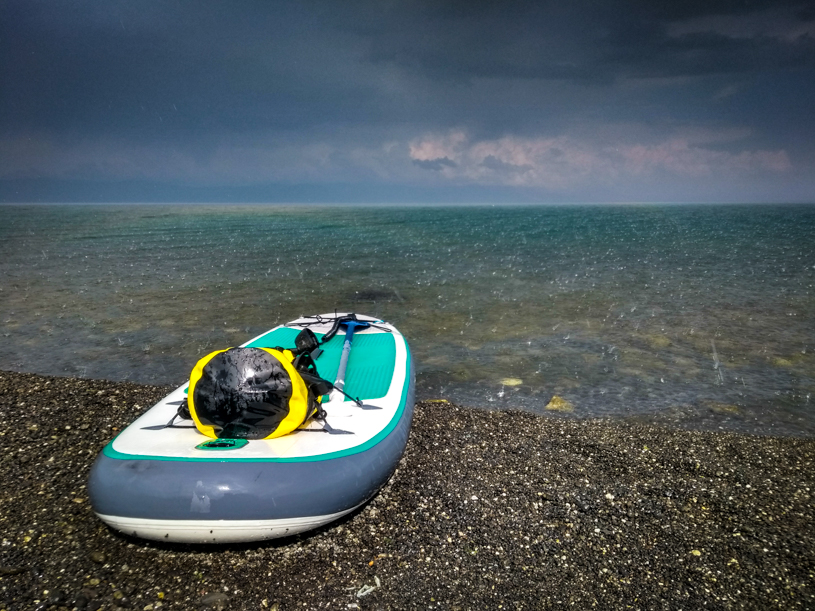
Here is grant winner Tenny Adamian’s account of circumnavigating Lake Sevan, Armenia, on a stand up paddle board (SUP).
Tenny won £200 towards her expedition from The Next Challenge Grant. The grant is open now for applications. Read more and apply here.
Stand-up Paddle Boarding Armenia’s Lake Sevan
by Tenny Adamian
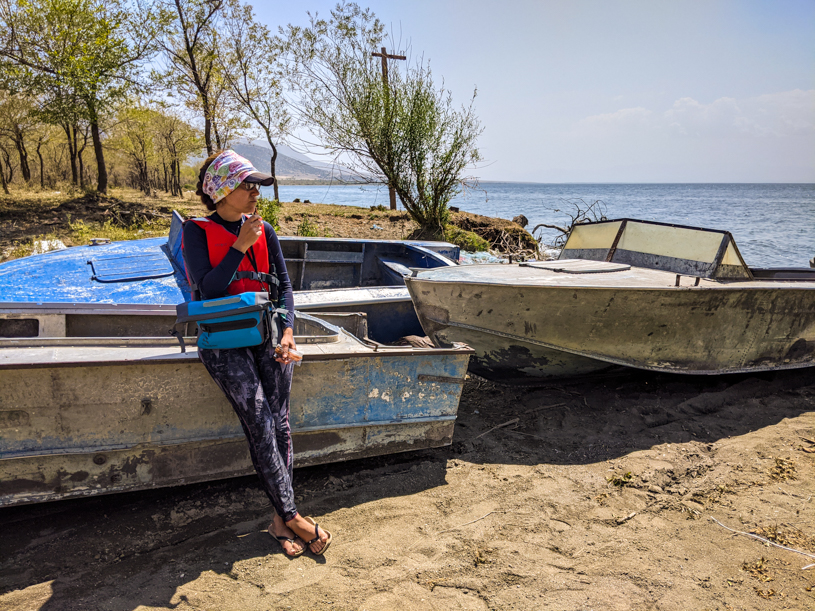
I heard a whistle from behind. Kneeling nervously on my board, I turned my head and saw Red Pepper, the famous red sailboat, and behind her the beach I had just departed from.
As the boat came closer, I spotted my friend’s six-year-old daughter Araxi. I had already said my goodbyes and dried my tears, but Samvel, the boat’s captain, had decided that this was more appropriate. He blew the whistle again as he skilfully turned the boat, while Araxi shouted, “byeee Tennyyy, byeeee!” at the top of her lungs.
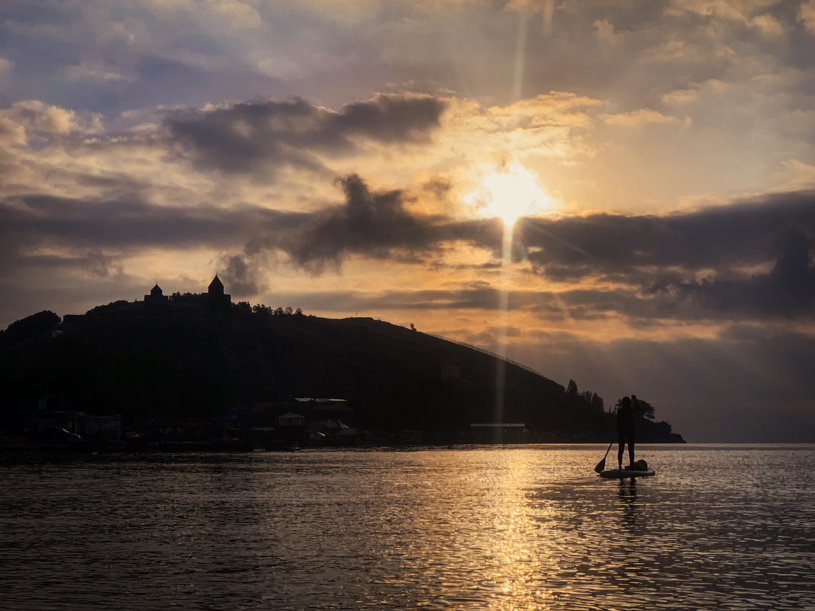
I wept, knowing that the wind would blow my emotions away before they reached them. I was heading south from Artanish, having paddled barely one kilometre, with 219 left to go to circumnavigate the largest lake in the Caucasus: Lake Sevan, in Armenia.
The sun came out and the wind calmed. Tentatively I got to my feet. Samvel had warned me to watch out for tree stumps submerged by the rising level of the lake. I pictured underwater forests waiting to catch me by surprise, break my fin and drag me down. The sunlit water darkened and suddenly I’d collapsed to my knees, heart pounding, as I floated uneventfully over the first big tree stump and its roots; one of many I would come across during the next few weeks. The power of these imagined fears was exhausting – harder, it seemed, than the paddling itself.
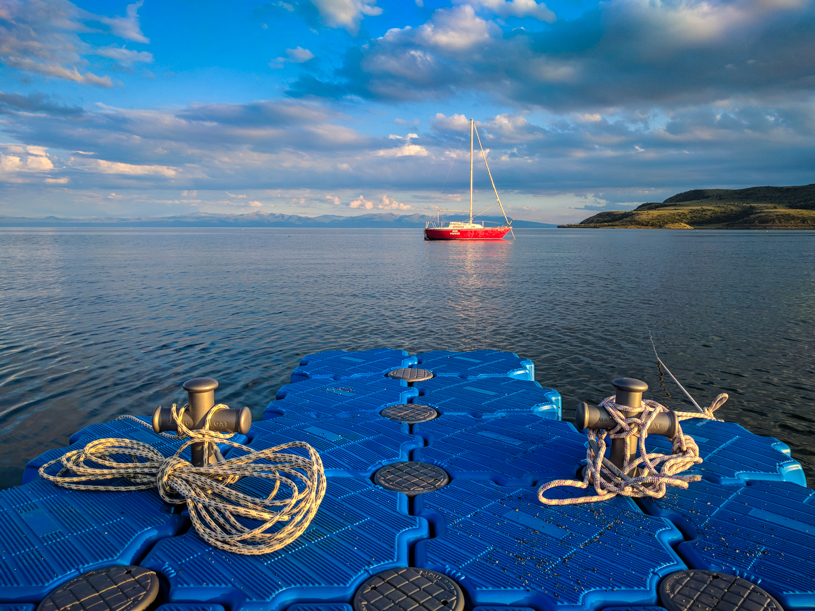
“I can see you! Over.”
Tom’s voice crackled over the radio, and there he was, waiting on the shore for my arrival. I was reminded that I had a support vehicle that would follow me all the way. I steered towards the shore. Coffee was ready.
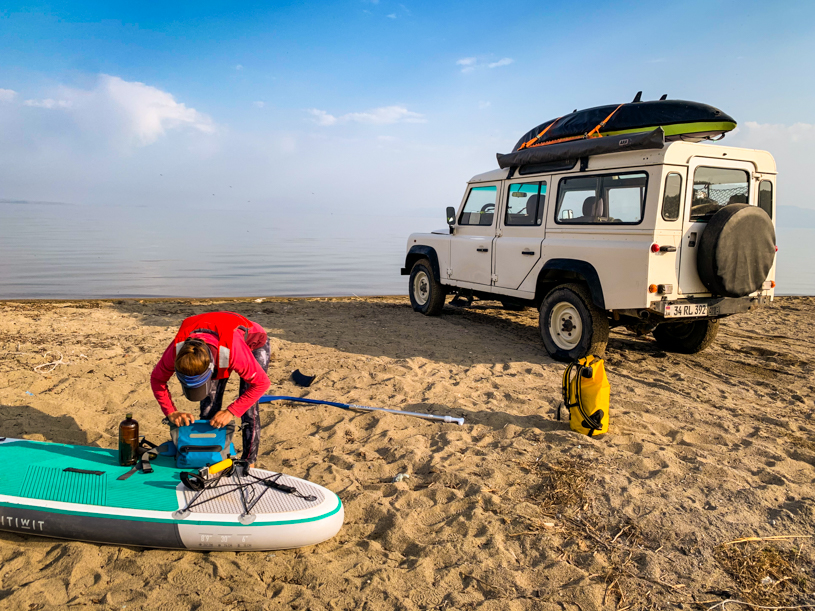
***
“This lake would be a great place for non-motorised water sports,” I’d said to a friend on a hot summer day. I’d just returned from Australia, having tried stand-up paddleboarding for the first time. “Be careful!”, I’d then shouted, warning the kids in water as a jet ski interrupted the peace.
I blamed that jet ski for igniting my curiosity to see it all from the point of view of “blue-eyed Sevan”, as it’s known amongst Armenians. I was here to find out what this mountain-fringed, pine-clad, high-altitude lake had to offer, to try and understand the many challenges it faced – and simply to see if I could do what had never been previously attempted.
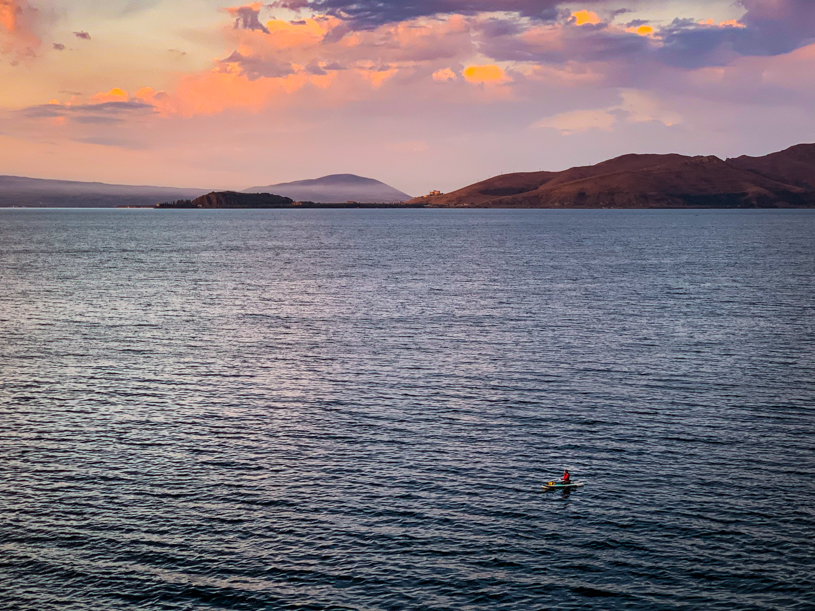
At the southern end of the lake, while skirting a large area of wetland near Vardenis, a sudden change of weather caught me by surprise. Suddenly the waves and the wind were pushing me in every direction at once. I paddled for my life, trying to avoid patches of underwater grass, fishing line floats, and invisible underwater tree stumps, not a soul to be seen as I fought my private battle with the elements for what seemed like an eternity.
“Did you capsize?”, Tom asked, after we finally reached a small beach.
“No,” I replied. I was shaking.
“Did you drown?”
“No.”
“Did you die?”
“No.”
I looked up, saw the grin on his face, and smiled.
“Did you get to the shore against the waves and wind all by yourself?”
“Yes!”
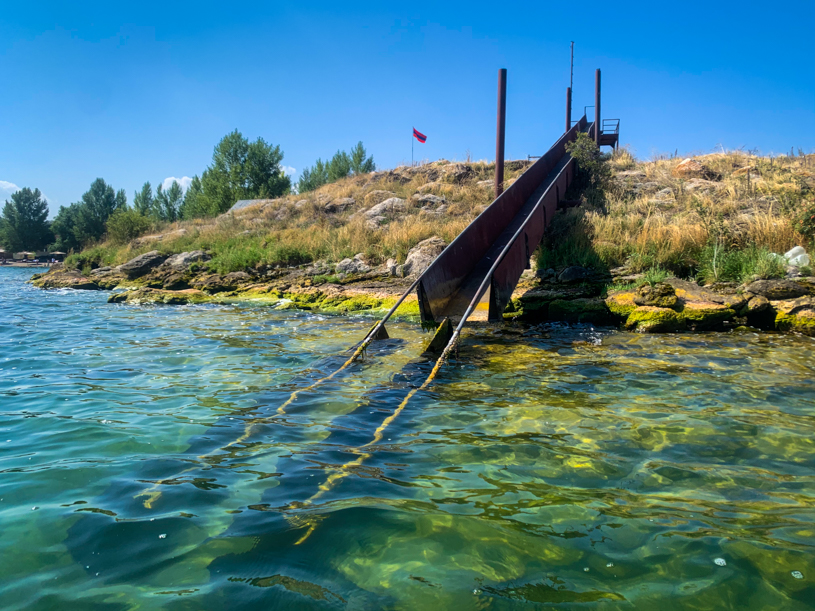
The questions were his way of getting me to admit that everything was okay. After hearing me begging for help over the radio, he had come to meet me in the kayak he was carrying on the roof of the vehicle. But in my heart, I knew this hadn’t been an emergency but a harsh reminder of my vulnerability.
I was still feeling a rush of fear every time I floated over a row of tree stumps or an old water pipe or the remains of a pier, refracted through the water and larger than life. But by now I’d learned what to look for, how to manoeuvre, and how to manage my fears in order to keep going.
* * *
As I’d followed the shoreline clockwise and begun travelling north, the lake had become more populated. One property in particular claimed a special place on the list of illegally-built oligarchs’ mansions. As I passed the first of the giant, prison-like walls that rose high above the water, I realised that while the place was protected from all sides on land, the waterfront itself was wide open – as if no one had ever anticipated a surprise visit from a paddler. The neat garden was filled with rose bushes in full bloom. A swimming pool sat empty in front of the austere grey villa. Am I trespassing? I wondered, drifting alongside the private promenade, waiting for a dog to bark or a security guard to shout at me. But all was silent, with no-one to be seen. I let a gentle tailwind escort me away before my luck ran out.
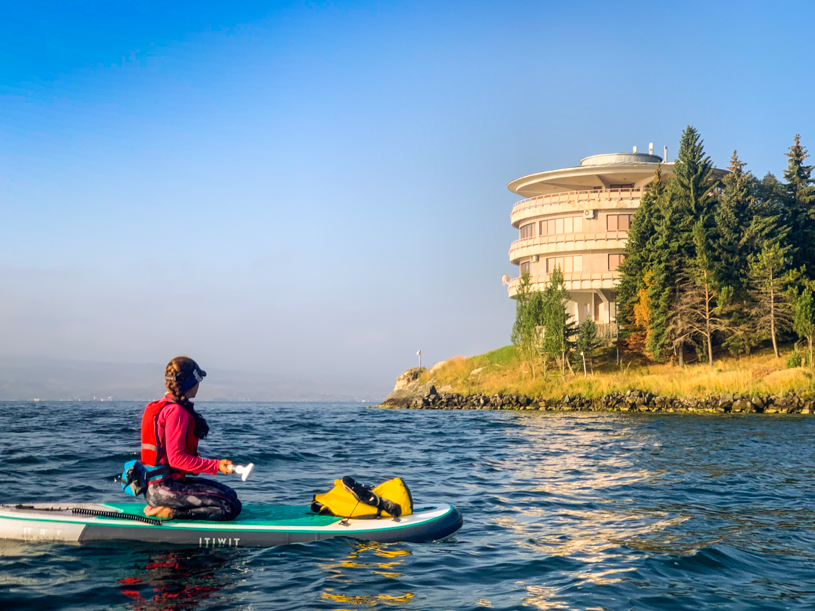
The mansion stood on a headland facing Sevan Peninsular and the famous Sevanavank monastery. The shoreline here was a favourite summer holiday destination for working-class Armenians, featuring pop music and beaches filled with picnic shelters, each hosting a family feast.
I paddled my way through barbecue smoke, screaming children and rented jet skis. After the little-visited shores of the southern half of the lake, this was the place I’d been dreading the most. But despite the chaos there was something charming about it. People were happy. This is what Lake Sevan meant to them. They invited me to join them, curious about a watersport they had never seen before, applauding my story, and giving me the encouragement I needed for the final push around the northern tip of the lake and back to Artanish.
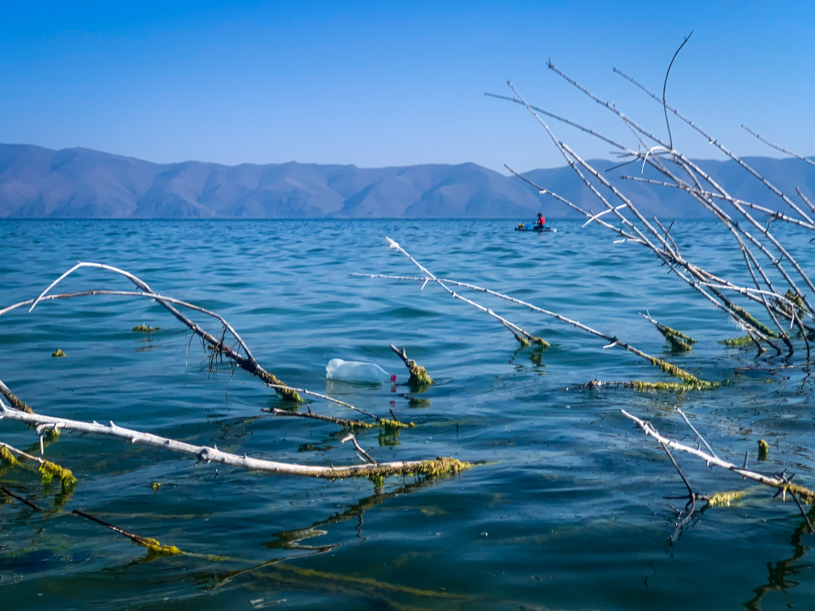
* * *
I rolled my tired body over the sun heated pebbles. My gaze scanned each pebble until it met the metallic blue of the water even more vibrant in contrast with the red sailboat anchored offshore. All the doubts about whether or not I could overcome this challenge had floated away replaced with gratitude to all those that made this journey possible.
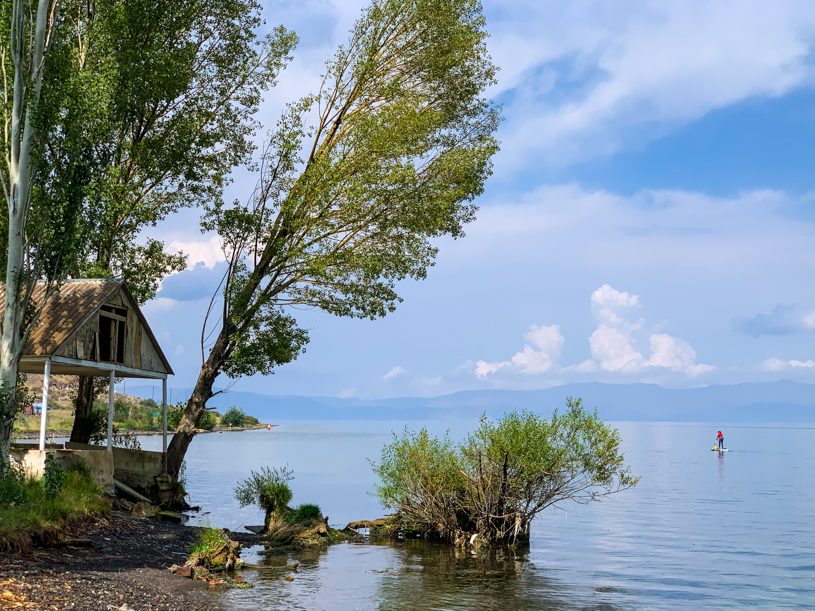
The Next Challenge Grant is open for applications until 31st January 2022. It is open to anyone, anywhere in the world and no experience is required. Apply now.
What do you think? Please do add your thoughts below…